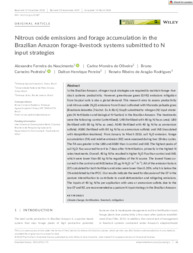Nitrous oxide emissions and forage accumulation in the Brazilian Amazon forage-livestock systems submitted to N input strategies.
Nitrous oxide emissions and forage accumulation in the Brazilian Amazon forage-livestock systems submitted to N input strategies.
Author(s): NASCIMENTO, A. F. do; OLIVEIRA, C. M. de; PEDREIRA, B. C. e; PEREIRA, D. H.; RODRIGUES, R. de A. R.
Summary: In the Brazilian Amazon, nitrogen input strategies are required to maintain forage-livestock systems productivity. However, greenhouse gases (GHG) emissions mitigation from tropical soils is also a global demand. This research aims to assess productivity and nitrous oxide (N2O) emissions from Oxisol cultivated with Marandu palisade grass (Brachiaria brizantha [Hochst. Ex A.Rich.] Stapf) submitted to nitrogen (N) input strategies (N fertilization and biological N fixation) in the Brazilian Amazon. The treatments were the following: control (unfertilized); U40 (fertilized with 40 kg N/ha as urea); U80 (fertilized with 80 kg N/ha as urea); AS40 (fertilized with 40 kg N/ha as ammonium sulfate); AS80 (fertilized with 80 kg N/ha as ammonium sulfate); and IAB (inoculated with Azospirillum brasilense ). From January to March 2016, soil N2O emission, forage accumulation (FA) and relative emission (RE) were assessed during two 28-day cycles. The FA was greater in the U80 and AS80 than in control and IAB. The highest peaks of soil N2O flux occurred from 4 to 7 days after N fertilization, primarily in the highest N rates treatments. Overall, 40 kg N/ha resulted in higher N2O flux than control and IAB, which were lower than 80 kg N/ha regardless of the N source. The lowest fluxes occurred in the control and IAB (below 20 ug N-N2O m-2 hr-1). All of the emission factors (EF) calculated for both fertilizers and rates were lower than 0.35%, which is below the 1% established by the IPCC. Our results indicate the need for discussion of the EF in the pasture intensification to contribute to avoid deforestation and mitigating emissions. The inputs of 40 kg N/ha per application with urea or ammonium sulfate, due to the low EF and RE, are recommended as a pasture N input strategy in the Brazilian Amazon.
Publication year: 2021
Types of publication: Journal article
Keywords: Climate change, Fertilizante, Fertilizers, Livestock, Mitigação, Mudança Climática, Pecuária
Observation
Some of Embrapa's publications are published as ePub files. To read them, use or download one of the following free software options to your computer or mobile device. Android: Google Play Books; IOS: iBooks; Windows and Linux: Calibre.
Access other publications
Access the Agricultural Research Database (BDPA) to consult Embrapa's full library collection and records.
Visit Embrapa Bookstore to purchase books and other publications sold by Embrapa.

